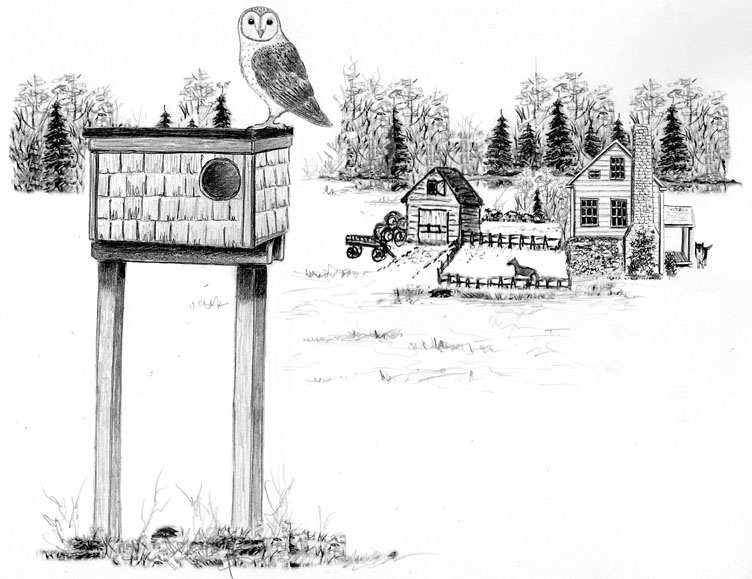
Dear Bird Folks,
I’ve recently become interested in owls. It all started back in 2013 when the Cape was visited by an abnormally high number of Snowy Owls. Since then I’ve seen Great Horned Owls and had a screech-owl use the nest box in my backyard. The next owl on my wish list is the Barn Owl. Any advice on where I might see one around here?
– Stevie, Harwich, MA
So close, Stevie,
In last week’s column I mentioned that there is a delay between when I receive a question and when the answer is published in the newspaper. Usually time doesn’t affect the answer, but such is not the case with your question. I know of an owl prowl where you have a good chance to see a Barn Owl. However, the deadline to sign up for that prowl was four days ago. (See what I mean by “so close”?) More on that later.
Barn Owls are the most widely distributed owls in the world. They are found in North America, South America, Africa, Europe and Asia. Even distant islands such as the Galapagos and Australia* have Barn Owls. (*Yes, I know Australia is more commonly thought to be a continent and not an island, but that’s for the geography nerds to sort out.) These owls are seen just about everywhere except for one important location…Cape Cod. Why not the Cape? Barn Owls are essentially non-migratory, so they do better where the winters are milder. Unlike their cousins the Snowy Owls, which thrive in frigid temperatures, Barn Owls aren’t very well designed to deal with extreme cold and snow. As result, most Barn Owls tend to live south of New England. There is, however, one Mass location that is famous for having breeding Barn Owls. Where is this location? More on that later, too.
Many owls use the “watch and wait” approach to hunting. They sit high and watch for prey to reveal itself. But Barn Owls are active foragers. They hunt harrier-style, flying low over fields or marshes in search of mouthwatering mice and voles. They are such effective hunters that even total darkness can’t conceal prey. Instead of depending on their eyes, Barn Owls have the ability to capture and locate food by simply hearing its movements. It’s kind of spooky.
Speaking of spooky, when most people think of owls they also think of the classic owl “hoot” (or more precisely, “hoo,” as owls rarely pronounce the “t”). But the voice of the Barn Owl sounds nothing like any owl, bird or creature you’ve ever heard before. Their call is a raspy, bloodcurdling scream, sounding like a cross between a mountain lion and a dragon having a bad dream, and I’m not kidding. It’s that bad.
For years the best place in New England to see Barn Owls was Mass Audubon’s Felix Neck Wildlife Sanctuary on Martha’s Vineyard. The island’s surrounding ocean waters were just warm enough to provide the birds with suitable winter habitat. At one point, there were nearly thirty pairs of Barn Owls breeding on the island, with one pair nesting in a box attached to the sanctuary’s nature center. In an effort to show off its avian guests, the sanctuary set up a webcam. The cam allowed homebodies, or folks who didn’t want to deal with the annoying ferries, to watch the little owlets online. Then something bad happened. Remember the winter of 2015 and how hard it was? Well, that winter was especially hard on the Vineyard’s owls. Most of them, including the stars of the owl cam, didn’t make it to the spring. This was sad news for bird watchers and owl lovers (but the local population of mouthwatering mice and voles was ecstatic and they haven’t stopped celebrating…like Cub’s fans). With the loss of the Vineyard’s Barn Owl population we also lost an important place to see these special birds. Fortunately, Massachusetts has another island that’s also Barn Owl friendly. Wanna guess which island it is? Just look to the east.
Nantucket, the island that boaters love and whales still hate, is also a haven for Barn Owls. With the support of the Maria Mitchell Association, over forty Barn Owl “birdhouses” have been placed around the island. But these are not ordinary birdhouses; they look like small barns on stilts, or floating doghouses. (In case you’ve forgotten, doghouses are dwellings where dogs used to live before we all went nuts and decided they should sleep on our couches or in our beds.) These mini-barns not only gave the birds a place to raise their kids, but they are also a place where the birds can roost and get out of the elements. As recently as 2010, over sixty Barn Owls called Nantucket home, and even though the dreaded winter of 2015 also took its toll here, the birds appear to be recovering. Yay!
This brings us to the “so close” line that I open this discussion with. According the Maria Mitchell website, ornithologist Ginger Andrews will be leading an owl prowl on Sunday, Nov. 20th. Unfortunately, the deadline to sign up for the prowl has passed. But instead of cursing your bad luck, Stevie (like Cleveland Indians fans), I suggest you contact the center and tell them you’d like to be notified the next time they have an owl prowl. I know getting to Nantucket can be a pain, but I think going there would make for a fun outing. Plus, Nantucket is always a pleasant place to visit…unless you happen to be a whale, then probably not so much.